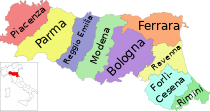Monte Battaglia
The toponym, attested in the Middle Ages as "Monte de Batalla" or "Montis Battagliae," has uncertain origins: according to some scholars[1] it refers to a great battle that was fought there between the Goths and Byzantines in the 6th century, while according to others its origin dates back to the time of Lombard domination (7th-8th centuries) and the term "battaglia" would be an alteration of the Lombard "pataia," meaning "rag," or "piece of cloth that flutters".
The position of Mount Battaglia later continued to represent the focal point of the military arrangements placed to control and defend the valleys of the two rivers and the plain between Imola and Faenza.
During the 16th century, the fortified works were superseded by the evolution of military technology, and Monte Battaglia also lost importance and prestige, so much so that in 1601 the city of Imola found no one willing to take on the position of castellan.
On 24 September 1944, a partisan battalion of the 36th Garibaldi Brigade, 250 men strong and divided into six companies, operating in the Imola and Faenza Apennines, began an infiltration movement that led it to occupy Mount Battaglia on the morning of the 27th.
On the other side of the mountain, unbeknownst to the partisans, soldiers of the 350th regiment of the U.S. 88th Infantry Division (Blue Devils), engaged in the breakthrough of the Gothic Line, were operating from south to north following the watershed between the Senio and Santerno rivers.
[4] This time, however, given also the proximity to the front line, having arrived on the mount, the partisans had to withstand in the rain an attack by the 290th German Grenadier Regiment, with members of the 44th and 715th Divisions, which were repelled also with the help of three companies of the Blue Devils.
[4] The fighting continued for another five days, but the Germans, despite reinforcements called up from the Adriatic front and help also obtained from forces of the Republic of Salò were again pushed back with heavy losses.
The fighting sustained by the partisan brigade alongside the U.S. Army was an episode of high strategic and military value as part of the liberation of Italy from the Nazi-Fascists.
The fighting was particularly bloody,[5] but the sacrifice of lives, with over 2,000 killed, did not bring immediate effects: despite the fact that the conquest of Monte Battaglia opened the way to the Po Valley, the Allied advance was halted, for reasons of military and political strategy, until the spring of the following year.

